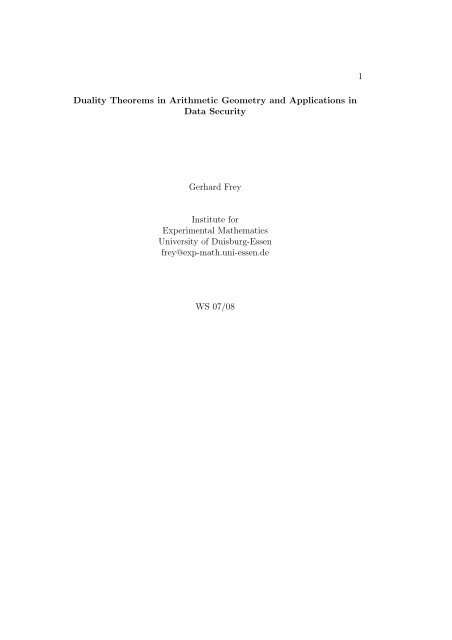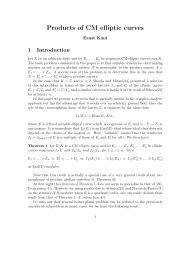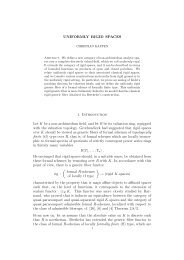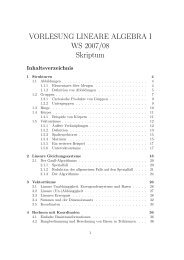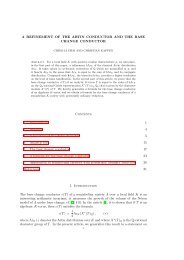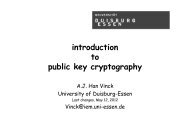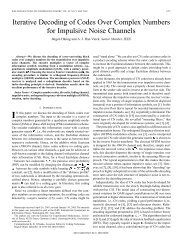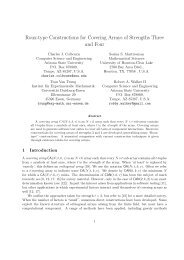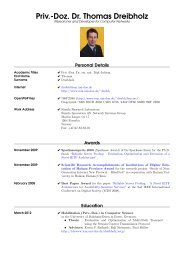1 Duality Theorems in Arithmetic Geometry and Applications in Data ...
1 Duality Theorems in Arithmetic Geometry and Applications in Data ...
1 Duality Theorems in Arithmetic Geometry and Applications in Data ...
You also want an ePaper? Increase the reach of your titles
YUMPU automatically turns print PDFs into web optimized ePapers that Google loves.
<strong>Duality</strong> <strong>Theorems</strong> <strong>in</strong> <strong>Arithmetic</strong> <strong>Geometry</strong> <strong>and</strong> <strong>Applications</strong> <strong>in</strong><br />
<strong>Data</strong> Security<br />
1<br />
Gerhard Frey<br />
Institute for<br />
Experimental Mathematics<br />
University of Duisburg-Essen<br />
frey@exp-math.uni-essen.de<br />
WS 07/08
Contents<br />
1 Crypto Primitives <strong>and</strong> Protocols 5<br />
1.0.1 Preambula . . . . . . . . . . . . . . . . . . . . . . . . . 5<br />
1.0.2 Exponential <strong>and</strong> Discrete Logarithm Systems . . . . . 6<br />
1.0.3 Algebraic DL-Systems . . . . . . . . . . . . . . . . . . 10<br />
1.0.4 The Diffie-Hellman Problems . . . . . . . . . . . . . . 11<br />
1.0.5 Examples . . . . . . . . . . . . . . . . . . . . . . . . . 12<br />
1.0.6 Generic Systems . . . . . . . . . . . . . . . . . . . . . 14<br />
1.0.7 The Index-Calculus Attack . . . . . . . . . . . . . . . . 15<br />
1.1 Bil<strong>in</strong>ear Structures . . . . . . . . . . . . . . . . . . . . . . . . 16<br />
1.1.1 Def<strong>in</strong>ition . . . . . . . . . . . . . . . . . . . . . . . . . 16<br />
1.1.2 <strong>Applications</strong> . . . . . . . . . . . . . . . . . . . . . . . . 17<br />
3
4 CONTENTS
Chapter 1<br />
Crypto Primitives <strong>and</strong><br />
Protocols<br />
1.0.1 Preambula<br />
To ensure a safe environment for data exchange <strong>and</strong> data storage is a very<br />
complex task <strong>in</strong>volv<strong>in</strong>g problems from quite different areas like eng<strong>in</strong>eer<strong>in</strong>g<br />
<strong>and</strong> computer science but also “human factors” <strong>and</strong> legal problems, <strong>and</strong> as<br />
a small but crucial component, mathematics. It is the task of mathematics<br />
to provide the particles called crypto primitives around which cryptographic<br />
protocols are developed. To estimate the security of these protocols is a<br />
difficult problem which is impossible if one cannot trust the primitives.<br />
In the follow<strong>in</strong>g lecture we shall try to discuss one special but most important<br />
family of crypto primitives based on the discrete logarithm problem <strong>in</strong><br />
groups. We shall describe how deep methods from arithmetical geometry<br />
<strong>and</strong> especially the <strong>in</strong>teraction between Galois theory <strong>and</strong> algebraic geometry<br />
over special fields can be used to construct them <strong>and</strong> to give estimates (or<br />
h<strong>in</strong>ts) for their reliability.<br />
The basic ideas go back to Diffie <strong>and</strong> Hellman. The ma<strong>in</strong> aim is the construction<br />
of a function f mapp<strong>in</strong>g the natural numbers N (or, <strong>in</strong> practice, a f<strong>in</strong>ite<br />
subset of N) to a f<strong>in</strong>ite set A of N satisfy<strong>in</strong>g some “functional equations” <strong>and</strong><br />
with the most important properties:<br />
• The function f can be evaluated rapidly at every element of N but<br />
5
6 CHAPTER 1. CRYPTO PRIMITIVES AND PROTOCOLS<br />
• for r<strong>and</strong>omly chosen y ∈ A the effort needed to compute x ∈ N with<br />
f(x) = y is very large, <strong>in</strong> the ideal case the brute force method “ TRY”<br />
should be the best strategy.<br />
So we have to f<strong>in</strong>d functions f together with algorithms to evaluate them<br />
with a proven small complexity, <strong>and</strong> we have to estimate the probability for<br />
f<strong>in</strong>d<strong>in</strong>g the <strong>in</strong>verse images by propos<strong>in</strong>g possible “attacks”. In contrast to the<br />
first task <strong>in</strong> almost all cases the second one cannot be solved <strong>in</strong> a satisfactory<br />
way. What we can get are estimates for this complexity from above which<br />
will lead to reject some functions f <strong>and</strong> the statement that “ to our best<br />
knowledge” other functions are safe “<strong>in</strong> the moment”.<br />
S<strong>in</strong>ce the security of the whole crypto system depends on this rather vague<br />
statement we would feel much better if we could use for f a one way function<br />
<strong>in</strong> the sense of <strong>in</strong>formation theory, or a trap door one way function (for the<br />
def<strong>in</strong>ition cf. [21]).<br />
But s<strong>in</strong>ce we even don’t know whether such functions exist we have to use<br />
what we have <strong>and</strong> to be very sensitive to new developments <strong>in</strong> technology<br />
( e.g. “quantum computers” (cf. [26])) <strong>and</strong> to new results <strong>in</strong> mathematics.<br />
We refer to the rather spectacular progress <strong>in</strong> recent years <strong>in</strong> factoriz<strong>in</strong>g<br />
numbers (by sieve methods <strong>in</strong> number fields), <strong>in</strong> count<strong>in</strong>g po<strong>in</strong>ts on curves<br />
over f<strong>in</strong>ite fields (cf. [1] <strong>and</strong> the references there<strong>in</strong>) <strong>and</strong> <strong>in</strong> apply<strong>in</strong>g <strong>in</strong>dexcalculus<br />
methods to Discrete Logarithm Systems ([14] <strong>and</strong> [7]).<br />
1.0.2 Exponential <strong>and</strong> Discrete Logarithm Systems<br />
Let A be a f<strong>in</strong>ite subset of N. For normalization reasons we shall assume<br />
that 1 ∈ A.<br />
Let<br />
e : N × A → A<br />
be a function satisfy<strong>in</strong>g a functional equation:<br />
For all n 1 , n 2 ∈ N one has<br />
e(n 1 , e(n 2 , 1)) = e(n 1 · n 2 , e(1, 1)).<br />
This is enough to organize a key exchange:<br />
Two parties M 1 , M 2 want to agree on a common secret key based on e. The
7<br />
communication uses a public channel.<br />
Key exchange scheme: 1<br />
i) M i chooses (as r<strong>and</strong>omly as possible) a number n i which never leaves the<br />
secure environment of M i .<br />
ii) M i sends y i := e(n i , 1).<br />
iii) M 1 computes e(n 1 , y 2 ), M 2 computes e(n 2 , y 1 ).<br />
S<strong>in</strong>ce<br />
e(n 1 , y 2 ) = e(n 1 , e(n 2 , 1)) = e(n 1 n 2 , e(1, 1)) = e(n 2 , e(n 1 , 1)) = e(n 2 , y 1 )<br />
M 1 <strong>and</strong> M 2 share the common key<br />
S = e(n 1 n 2 , e(1, 1)).<br />
It is obvious that the secrecy of S depends on the secrecy of n i <strong>and</strong> so on the<br />
difficulty to compute n i from the knowledge of y i = e(n i , 1).<br />
So we assume that the function e(n, a) as function of the first variable behaves<br />
like a one way function. Then we call<br />
(e : N × A → A; e(1, 1))<br />
an exponential system with base po<strong>in</strong>t e(1, 1).<br />
For many applications one needs more “structure”. For <strong>in</strong>stance the signature<br />
of a message m can use a scheme of ElGamal type if we have a rapidly<br />
computable function<br />
⊕ : A × A → A<br />
which we require to be associative. In other words we require that A is a<br />
semigroup.<br />
Us<strong>in</strong>g this associativity we def<strong>in</strong>e <strong>in</strong> the usual way for n ∈ N <strong>and</strong> a ∈ A<br />
n ◦ a<br />
as the n − 1 fold application of ⊕ to a.<br />
1 We do not go <strong>in</strong>to details of how this protocol has to be ref<strong>in</strong>ed <strong>in</strong> order to become as<br />
secure as its primitive, the function e.
8 CHAPTER 1. CRYPTO PRIMITIVES AND PROTOCOLS<br />
Remark 1.0.1 Of course the actual computation of n◦a uses the well known<br />
method of (for <strong>in</strong>stance) develop<strong>in</strong>g n <strong>in</strong> the b<strong>in</strong>ary system <strong>and</strong> then “add<strong>in</strong>g<br />
<strong>and</strong> doubl<strong>in</strong>g” accord<strong>in</strong>gly. This bounds the number of compositions ◦ by 2 log<br />
n. Several variants can be used to accelerate <strong>and</strong> sometimes precalculations<br />
speed up even more.<br />
Use this to def<strong>in</strong>e<br />
by<br />
e : N × A → A<br />
e(n, a) := n ◦ a.<br />
Obviously the function e satisfies the functional equation:<br />
For all n 1 , n 2 ∈ N , a ∈ A we have<br />
e(n 1 , e(n 2 , a)) = e(n 1 n 2 , a)<br />
<strong>and</strong> especially<br />
e(n 1 , e(n 2 , 1)) = e(n 1 n 2 , e(1, 1)).<br />
Signature<br />
Let e be as above.<br />
e satisfies a second functional equation<br />
e(n 1 , a) ⊕ e(n 2 , a) = e(n 1 + n 2 , a).<br />
This equation is used for signature schemes of El Gamal type. We shall give<br />
one variant:<br />
Aim: M wants to sign a message m <strong>in</strong> such a way that everybody can check<br />
the authenticity of m but no one can fake the contents of m or the name of<br />
M.<br />
To <strong>in</strong>itialize the system M chooses, aga<strong>in</strong> r<strong>and</strong>omly <strong>and</strong> secretly, his private<br />
key x ∈ N <strong>and</strong> publishes his public key Y := e(x, 1).<br />
This number Y identifies M <strong>in</strong> public.<br />
Sign<strong>in</strong>g a message M uses, <strong>in</strong> addition to the DL-system, a (publicly known)<br />
hash function h which maps N to a set of numbers of bounded size. It has
to have properties similar to those of one way functions. Especially it has to<br />
be impossible <strong>in</strong> practice to construct a number z such that h(z) is a given<br />
value. (For hash functions cf. [21].)<br />
9<br />
Signature 1 M chooses a second r<strong>and</strong>om number k <strong>and</strong> computes<br />
s := h(m)x + h(e(k, 1))k.<br />
The signed message consists of<br />
(m, e(k, 1), s)<br />
To check the authenticity of (M, m) one computes<br />
S = e(s, 1), P = e(h(m), Y )), H = e(h(e(k, 1)), e(k, 1)).<br />
Now the functional equations of e imply:<br />
S = P ⊕ H<br />
if the signature is authentic. Otherwise it is rejected.<br />
It is obvious that the security of the signature depends on the quality of<br />
e(., 1) as one-way function, but it is easily seen that this is not enough.<br />
Logarithms<br />
Def<strong>in</strong>ition 1.0.2 The notation is as above.<br />
For given a <strong>in</strong> A <strong>and</strong> b ∈ {n ◦ a, n ∈ N} the logarithm of b with respect<br />
to a is a number log a (b) := n b ∈ N with n b ◦ a = b.<br />
Complexity Hierarchy<br />
To have a more precise statement on the complexity of algorithms we measure<br />
it by the function<br />
L p (α, c) := exp(c(log p) α (log log p) 1−α )
10 CHAPTER 1. CRYPTO PRIMITIVES AND PROTOCOLS<br />
with 0 ≤ α ≤ 1 <strong>and</strong> c > 0.<br />
The best case for a cryptosystem is α = 1 – then one has exponential complexity,<br />
this means that the complexity of solv<strong>in</strong>g the DLP is exponential <strong>in</strong><br />
the b<strong>in</strong>ary length of the group size log p. The worst case is when α = 0 – then<br />
the system only has polynomial complexity. For 0 < α < 1 the complexity is<br />
called subexponential.<br />
Def<strong>in</strong>ition 1.0.3 The notation is as above. Let C be a positive real number.<br />
(⊕ : A × A → A, 1)<br />
is a Discrete Logarithm System (DL-systems) of exponential security<br />
C if for r<strong>and</strong>om elements a, b ∈ A the computation of log a (b) has<br />
(probabilistic) complexity 2 ≥ e C·log(|A|) .<br />
So DL-systems with exponential security C with C not too small give rise to<br />
exponential systems. We hope that we can f<strong>in</strong>d DL-systems with exponential<br />
security 1/2.<br />
But there are important examples which have only sub exponential security.<br />
This does not mean that we cannot use these systems but we have to choose<br />
larger parameters.<br />
1.0.3 Algebraic DL-Systems<br />
Let (G, ×) be a f<strong>in</strong>ite group.<br />
For our purposes the way how to present the group elements <strong>and</strong> the composition<br />
law is essential.<br />
Def<strong>in</strong>ition 1.0.4 A numeration (A, f) of G is a bijective map<br />
f : G → A<br />
where A is a f<strong>in</strong>ite subset of N conta<strong>in</strong><strong>in</strong>g 1.<br />
A presentation of an abstract f<strong>in</strong>ite group G is an embedd<strong>in</strong>g of G <strong>in</strong>to a<br />
group with numeration.<br />
2 In the whole paper the measure for complexity is the number of needed bit-operations.
Assume that (A, f) is a numeration of the f<strong>in</strong>ite group G <strong>and</strong> that g 0 ∈ G<br />
with f(g 0 ) = 1 is given.<br />
11<br />
Def<strong>in</strong>e<br />
by<br />
Then for n ≥ 1 we have<br />
⊕ : A × A → A<br />
a 1 ⊕ a 2 := f(f −1 (a 1 ) × f −1 (a 2 )).<br />
e(n, a) = f(n ◦ f −1 (a))<br />
as one sees easily by <strong>in</strong>duction.<br />
Especially we get: e(n, 1) = f(n ◦ g 0 ).<br />
We want to make one th<strong>in</strong>g completely clear: We require that ⊕ is rapidly<br />
computable without the knowledge of f −1 <strong>and</strong> that we can th<strong>in</strong>k of G as an<br />
abstract group (i.e. we look at it up to isomorphisms) but the security <strong>and</strong><br />
the efficiency of the DL-System based on ⊕ will depend crucially on f.<br />
We can ref<strong>in</strong>e our signature scheme 1:<br />
Signature 2 Let n be the order of G. Let (A, f) be a numeration of G <strong>and</strong><br />
e(., .) as above. The signature procedure of a sender M <strong>and</strong> a message m is<br />
as described <strong>in</strong> Subsection 1.0.2 except that we replace <strong>in</strong> the equation of 1<br />
all numbers by their smallest positive residue modulo n:<br />
The signature of m given by M is (m, e(k, 1), s) with<br />
<strong>and</strong> x, k, s, h(.) ∈ {0, · · · , n − 1}.<br />
s ≡ h(m)x + h(e(k, 1))k mod n<br />
1.0.4 The Diffie-Hellman Problems<br />
Computational Diffie-Hellman problem
12 CHAPTER 1. CRYPTO PRIMITIVES AND PROTOCOLS<br />
For r<strong>and</strong>om a ∈ A to compute<br />
log a0<br />
(a) (CDH)<br />
is hard.<br />
For many applications an even stronger condition is needed:<br />
Decision Diffie-Hellman problem<br />
For r<strong>and</strong>om triples (a 1 , a 2 , a 3 ) decide whether<br />
log a0<br />
(a 3 ) = log a0<br />
(a 1 ) log a0<br />
(a 2 ).<br />
(DDH)<br />
1.0.5 Examples<br />
Example 1:<br />
We take a prime number p <strong>and</strong> the set G := Z/p together with its addition.<br />
Hence we deal with “the” group with p elements.<br />
As numeration we take the map<br />
given by<br />
f : G → {1, · · · , p}<br />
f(r + pZ) := [r] p<br />
where [r] p is the smallest positive representative of the class of r modulo p.<br />
The function ⊕ is given by<br />
r 1 ⊕ r 2 = [r 1 + r 2 ] p<br />
which is easy to compute from the knowledge of r i .<br />
What about security? We can assume that a ∈ {1, · · · , p − 1} <strong>and</strong> b =<br />
e(n, a) = [na] p . To determ<strong>in</strong>e n we have to solve the equation<br />
b = na + kp
with k ∈ Z. But by us<strong>in</strong>g the Euclidean algorithm this task is done <strong>in</strong><br />
O(log(p)) operations <strong>in</strong> Z <strong>and</strong> so n is computed very rapidly. Hence the<br />
complexity to compute the DL is polynomial (even l<strong>in</strong>ear).<br />
We can generalize the example easily to subgroups <strong>in</strong> the additive group of<br />
fields of characteristic p or to subspaces of vector spaces over Z/p.<br />
Example 2: Aga<strong>in</strong> we take G = Z/p. In addition we choose a prime q such<br />
that p divides q − 1. As it is well known this implies the existence of an<br />
element ζ ≠ 1 <strong>in</strong> Z/q with ζ p = 1 (i.e. ζ is a primitive p-th root of unity).<br />
Now def<strong>in</strong>e for 1 ≤ i ≤ p the number z i := [ζ i ] q <strong>and</strong> for ī = i + pZ ∈ G<br />
f(ī) := [z i − z 1 + 1] q .<br />
13<br />
Then f def<strong>in</strong>es an <strong>in</strong>jection of G <strong>in</strong>to {1, · · · q} with f(1 + pZ) = 1. Let A<br />
denote the image of f.<br />
Us<strong>in</strong>g the addition <strong>in</strong> G we get for a i = f(x i + pZ) ∈ A<br />
a 1 ⊕ a 2 = [[ζ x 1+x 2<br />
] q − z 1 + 1] q .<br />
As stressed above it is important that one can compute a 1 ⊕ a 2 without<br />
know<strong>in</strong>g x 1 <strong>and</strong> x 2 . For this purpose we use the rules for addition <strong>and</strong><br />
multiplication <strong>in</strong> Z/p <strong>and</strong> get:<br />
a 1 ⊕ a 2 = [(a 1 + z 1 − 1)(a 2 + z 1 − 1) − z 1 + 1] q<br />
<strong>and</strong><br />
e(n, 1) = n ◦ 1 = [z n 1 − z 1 + 1] q .<br />
What about security <strong>in</strong> this system? For fixed a <strong>and</strong> r<strong>and</strong>om b ∈ A we have<br />
to f<strong>in</strong>d n <strong>in</strong> N with<br />
b = e(n, a) = n ◦ a = [a n − z 1 + 1] q .<br />
Essentially this means that for one fixed p-th root of unity <strong>and</strong> one r<strong>and</strong>om<br />
p-th root of unity <strong>in</strong> the multiplicative group of Z/q one has to determ<strong>in</strong>e<br />
the exponent needed to transform the fixed root of unity <strong>in</strong>to the r<strong>and</strong>om<br />
element. This expla<strong>in</strong>s the name “discrete logarithm” <strong>in</strong>troduced above.
14 CHAPTER 1. CRYPTO PRIMITIVES AND PROTOCOLS<br />
Indeed to our knowledge at present a system based on this numeration is quite<br />
safe though for all constants C there is a number p 0 such that for all primes<br />
p ≥ p 0 the correspond<strong>in</strong>g DL-system it not of exponential security C. The<br />
best known method to compute the discrete logarithm is “subexponential”<br />
(cf. [1]). The suggested size of p is at least 2048 bits.<br />
1.0.6 Generic Systems<br />
In the examples <strong>in</strong> the last subsection we already had more structure available<br />
than necessary for us: The set A was the image of the numeration f of a<br />
f<strong>in</strong>ite cyclic group G. This will be so <strong>in</strong> the follow<strong>in</strong>g sections, too.<br />
This seems to be reasonable: The part of the numeration we use for key<br />
exchange <strong>and</strong> signatures is given by the numeration of the group generated<br />
by f −1 (1). But it would be <strong>in</strong>terest<strong>in</strong>g to study whether one can w<strong>in</strong> security<br />
by generat<strong>in</strong>g this numeration by a more complicated group like a general<br />
matrix group.<br />
Next we used <strong>in</strong> the signature scheme 2 the order of G. There are crypto<br />
systems which are based on the assumption that one cannot compute this<br />
order or that one can compute it only by us<strong>in</strong>g a secret trapdoor function<br />
(RSA-like systems). Here we do not enter <strong>in</strong>to these very <strong>in</strong>terest<strong>in</strong>g discussions<br />
but assume that the order of G <strong>and</strong> even its prime factorization are<br />
given.<br />
An easy application (by some people called “Pohlig-Hellman attack”) of the<br />
Ch<strong>in</strong>ese rema<strong>in</strong>der theorem <strong>and</strong> p-adic expansion shows that the security of<br />
the discrete logarithm attached to G <strong>and</strong> so a forteriori of the cryptographic<br />
schemes is reduced to the difficulty to compute the DL <strong>in</strong> the subgroups of<br />
G with prime order. Hence we have to restrict ourselves to cyclic groups of<br />
order p where p is a prime number which is sufficiently large.<br />
We can formulate the mathematical task to be solved more precisely now:<br />
We have to f<strong>in</strong>d numerations f of groups Z/p with p large enough which<br />
satisfy:<br />
• Time needed (probabilistically) for the computation of the logarithm<br />
<strong>in</strong> f(Z/p) is exponential <strong>in</strong> log(p).
• Time needed to write down the elements <strong>and</strong> to execute the composition<br />
⊕ is polynomial <strong>in</strong> log(p).<br />
But hav<strong>in</strong>g decided to use the algebraic structure “group” <strong>in</strong> the construction<br />
of the crypto primitive “DL” we have added a lot of structure to our system.<br />
So it is important which methods are available to attack crypto systems which<br />
use “just” groups <strong>and</strong> the result<strong>in</strong>g DL-problems. For a very <strong>in</strong>terest<strong>in</strong>g<br />
discussion of different types of <strong>in</strong>formation which can weaken the protocols<br />
we refer to [19].<br />
Of course the worst case is that the discrete logarithm can be computed.<br />
Here the amaz<strong>in</strong>g fact is that we can do much better than brute force attacks:<br />
The Baby-Step-Giant-Step method of Shanks as well as the ρ- <strong>and</strong> Λ-methods<br />
of Pollard work <strong>in</strong> every f<strong>in</strong>ite group. All of them have time-complexity<br />
O(p 1/2 ) <strong>and</strong> the methods of Pollard need very little storage space (for more<br />
details cf. [21]).<br />
These attacks give a first upper bound for the optimal exponential complexity<br />
of the Discrete Logarithm <strong>in</strong> f<strong>in</strong>ite groups: The constant C = 1/2 is the best<br />
one can hope for, <strong>and</strong> so we are forced to choose p of a size near to 10 80<br />
<strong>in</strong>stead of 10 40 .<br />
15<br />
1.0.7 The Index-Calculus Attack<br />
In reality we shall have to use a concrete presentation of our group. In many<br />
examples there are elements <strong>in</strong> G which are easier to deal with, <strong>and</strong> this gives<br />
rise to the <strong>in</strong>dex-calculus attack.<br />
The pr<strong>in</strong>ciple of <strong>in</strong>dex-calculus methods <strong>in</strong> abelian groups G is to f<strong>in</strong>d a<br />
“factor base” consist<strong>in</strong>g of relatively few elements <strong>and</strong> to compute G as<br />
Z−module given by the free abelian group generated by the base elements<br />
modulo relations.<br />
As next step one has to prove that with high probability every element of G<br />
can be written (fast <strong>and</strong> explicitly) as a sum of elements <strong>in</strong> the factor base.<br />
The important task <strong>in</strong> this method is to balance the number of elements <strong>in</strong><br />
the factor base to make the l<strong>in</strong>ear algebra over Z manageable <strong>and</strong> to guarantee<br />
“smoothness” of arbitrary elements with respect to this base. Typically<br />
successes give rise to algorithms for the computation of the DL <strong>in</strong> G which<br />
have subexponential complexity <strong>and</strong> so, for large enough order of G, the
16 CHAPTER 1. CRYPTO PRIMITIVES AND PROTOCOLS<br />
DL-systems have a poor exponential security.<br />
The effectiveness of this approach is the reason for the large numbers of bits<br />
required for safe RSA-systems <strong>and</strong> for DL-systems based on the multiplicative<br />
group of f<strong>in</strong>ite fields (Example 2 <strong>in</strong> the Subsection 1.0.5).<br />
In [7] one f<strong>in</strong>ds a very nice discussion of the <strong>in</strong>dex-calculus attack <strong>in</strong> a rather<br />
general frame. The results found there expla<strong>in</strong> why it is so effective <strong>in</strong> many<br />
cases.<br />
1.1 Bil<strong>in</strong>ear Structures<br />
1.1.1 Def<strong>in</strong>ition<br />
Let (A, ◦) be a DL-system.<br />
Def<strong>in</strong>ition 1.1.1 Assume that there are abelian groups A ′ , B <strong>and</strong> a map<br />
satisfy<strong>in</strong>g the follow<strong>in</strong>g requirements<br />
Q : A × A ′ → B<br />
• Q is computable <strong>in</strong> polynomial time (this <strong>in</strong>cludes that the elements <strong>in</strong><br />
B need only O(log | A |) space)<br />
• for all n 1 , n 2 ∈ N <strong>and</strong> r<strong>and</strong>om elements a 1 , a ′ 2 ∈ A × A ′ we have<br />
Q(n 1 ◦ a 1 , n 2 ◦ a ′ 2) = n 1 · n 2 ◦ Q(a 1 , a ′ 2)<br />
• Q(., .) is non degenerate. Hence, for r<strong>and</strong>om a ′ ∈ A ′ we have Q(a 1 , a ′ ) =<br />
Q(a 2 , a ′ ) iff a 1 = a 2 .<br />
Then we call (A, Q) a DL-system with bil<strong>in</strong>ear structure.
1.1. BILINEAR STRUCTURES 17<br />
Remark 1.1.2 One is used to describe bil<strong>in</strong>ear maps on free modules by<br />
matrices with entries equal to the values on pairs of base vectors. This does<br />
not help <strong>in</strong> our context. For <strong>in</strong>stance take A = B as cyclic group with n<br />
elements <strong>and</strong> generator P 0 <strong>and</strong> C := Z/n.<br />
For m ∈ Z prime to n def<strong>in</strong>e<br />
Q m : A × A → Z/n<br />
by Q m (P 0 , P 0 ) := m + nZ.<br />
Without further <strong>in</strong>formation the computation of Q m (P, Q) is equivalent with<br />
the Discrete Logarithm <strong>in</strong> A. So bil<strong>in</strong>ear maps are easy to be def<strong>in</strong>ed but it is<br />
much more difficult to f<strong>in</strong>d DL-Systems with bil<strong>in</strong>ear structure. As we shall<br />
see one possibility is to use <strong>Duality</strong> Theorem from <strong>Arithmetic</strong> <strong>Geometry</strong>.<br />
Example:<br />
1.)Let V be a vector space over F p with bil<strong>in</strong>ear map φ which maps V × V<br />
to a F p vector space W .<br />
Take a 0 ∈ V , A =< a 0 > <strong>and</strong><br />
< a 0 > ⊥ := {v ∈ V with φ(a 0 , v) = 0 V }.<br />
Take a ′ 0 ∈ V \ < a 0 > ⊥ , A ′ :=< a ′ 0 >, B := φ(< a 0 >, < a ′ 0 >) und<br />
Q = φ |A×A ′.<br />
2.) A little more general:<br />
Let ϕ : V → V ′ be a (computable(!)) l<strong>in</strong>ear map <strong>and</strong><br />
bil<strong>in</strong>ear. Def<strong>in</strong>e<br />
<strong>and</strong> then proceed as <strong>in</strong> example 1.<br />
φ ′ : V × V ′ → W<br />
φ := φ ′ ◦ (id V × ϕ)<br />
1.1.2 <strong>Applications</strong><br />
In the follow<strong>in</strong>g we always assume that the DL-system (A, ◦) has a bil<strong>in</strong>ear<br />
structure<br />
Q : A × A ′ → B.
18 CHAPTER 1. CRYPTO PRIMITIVES AND PROTOCOLS<br />
Transfer of DL<br />
The DL-system (A, ◦) is at most as secure as the system (B, ◦).<br />
For take r<strong>and</strong>om a ′ ∈ A ′<br />
<strong>and</strong> denote b 0 := Q(a 0 , a ′ ).<br />
Then the map<br />
< a 0 >→< b 0 ><br />
a := n ◦ a 0 ↦→ Q(a, a ′ )<br />
is a monomorphism of numerated groups, <strong>and</strong> the claim follows.<br />
DDH<br />
Assume that<br />
<strong>and</strong> hence<br />
A = A ′<br />
Q(a 0 , a 0 ) ≠ 0.<br />
Then for all triples (a 1 , a 2 , a 3 ) ∈< a 0 > one can decide <strong>in</strong> polynomial time<br />
(<strong>in</strong> log(p) whether<br />
holds. For we can use the identities<br />
log a0<br />
(a 3 ) = log a0<br />
(a 1 ) · log a0<br />
(a 2 )<br />
Q(a 1 , a 2 ) = log a0<br />
(a 1 ) · log a0<br />
(a 2 )Q(a 0 , a 0 ),<br />
Q(a 3 , a 0 ) = log a0<br />
(a 3 )Q(a 0 , a 0 ).
1.1. BILINEAR STRUCTURES 19<br />
Tripartite Key Exchange<br />
The follow<strong>in</strong>g is a nice idea of A. Joux (ANTS 4).<br />
Parties P 1 , P 2 , P 3 want to create a common secret.<br />
We assume that we have A with bil<strong>in</strong>ear structure Q on A × A.<br />
Each partner P i chooses a secret number s i <strong>and</strong> publishes<br />
a i := s i ◦ a 0 .<br />
Hence every partner can compute<br />
s 1 ◦ Q(a 2 , a 3 ) = s 2 ◦ Q(a 1 , a 3 ) = s 3 ◦ Q(a 1 , a 2 ),<br />
the common secret. (Semantical) Security needs<br />
1. hardness of the (computational) DL problem <strong>in</strong> A<br />
2. hardness of the follow<strong>in</strong>g problem called Bil<strong>in</strong>ear Diffie-Hellman-Problem<br />
(BDH):<br />
For (a, a 1 = n 1 ◦ a, a 2 = n 2 ◦ a, a 3 = n 3 ◦ a) compute<br />
n 1 n 2 n 3 ◦ Q(a, a).<br />
Identity based Protocol<br />
This is an old dream (of Shamir):<br />
One wants to send an encrypted message to a certa<strong>in</strong> person without build<strong>in</strong>g<br />
up a public key environment but by the use of one’s identity <strong>and</strong><br />
some trusted <strong>in</strong>stitution T A which computes a secret key <strong>and</strong> the related<br />
public one (<strong>and</strong> the public key does not give <strong>in</strong>formation about the identity!)<br />
We shall assume that A =< a 0 > <strong>and</strong> A ′ = A.<br />
We shall expla<strong>in</strong> an idea of Frankl<strong>in</strong> <strong>and</strong> Boneh: how to use it to come<br />
nearer to the dream. We have a sender Q who wants to transmit a message<br />
m to the receiver P . We shall assume that m ∈ (Z/2) n .
20 CHAPTER 1. CRYPTO PRIMITIVES AND PROTOCOLS<br />
Q uses the service of T A.<br />
Setup:<br />
There are two publicly known hash functions<br />
G : N → A<br />
<strong>and</strong><br />
H : B → (Z/2) n .<br />
T A chooses s, the master key, <strong>and</strong> publishes a pub := s ◦ a 0 .<br />
Generation of keys:<br />
P sends (after authentification) an element ID ∈ (Z/2) n represent<strong>in</strong>g his<br />
identity to T A.<br />
P (or T A, or the sender) computes<br />
<strong>and</strong> then as<br />
“public key” of P<br />
a ID := G(ID) ∈ A<br />
b ID := Q(a ID , a pub ).<br />
T A generates the “private key”<br />
of P .<br />
s ID := s ◦ a ID<br />
Encryption:<br />
The message is m ∈ (Z/2) n .<br />
Q chooses r r<strong>and</strong>omly <strong>and</strong> computes<br />
r ◦ a 0 <strong>and</strong> r · b ID<br />
<strong>and</strong> sends the ciphertext<br />
C := (r · a 0 , m ⊕ H(r · b ID )).
1.1. BILINEAR STRUCTURES 21<br />
Decryption:<br />
Let (U, V ) be a cyphertext.<br />
P computes<br />
T := H(Q(s ID , U)).<br />
Then m = V ⊕ T .<br />
Proof:<br />
S<strong>in</strong>ce V = m ⊕ H(r · b ID ) we have to show that Q(s ID , U) = r · b ID .<br />
But<br />
Q(s ID , U) = Q(s ◦ a ID , r · a 0 )<br />
= rsQ(a ID , a 0 ) = r · Q(a ID , s ◦ a 0 ) = r · b ID .<br />
(Semantical) Security<br />
needs aga<strong>in</strong> the hardness of (BDH).<br />
Work to do:<br />
Assume that T A has done the orig<strong>in</strong>al setup <strong>and</strong> has published<br />
A, B, Q, G, H, a 0 , a pub .<br />
To serve P it has to perform one scalar multiplication <strong>in</strong> A (with fixed argument<br />
a 0 ).<br />
The sender has to compute b ID by one application of Q with one argument<br />
(= a pub ) <strong>in</strong>dependent of P ,one scalar multiplication <strong>in</strong> A of a fixed element<br />
(a 0 ) <strong>and</strong> one scalar multiplication <strong>in</strong> B with argument depend<strong>in</strong>g on ID.<br />
P has to get his private key from T A <strong>and</strong> to compute Q (with one argument<br />
<strong>in</strong>dependent of the message <strong>and</strong> the sender).<br />
In all cases precomputation is possible to accelerate the computation.<br />
Advantage:<br />
For the sender: He can send a message to a receiver who does not have a<br />
public key system before. (But he has to be sure that there is a TA which<br />
will communicate with P .)<br />
For the receiver P : He has not to have a public or private key but only a<br />
ID before a message comes. So for <strong>in</strong>stance T A could become active after a<br />
message arrives.<br />
Big disadvantage:<br />
T A knows everyth<strong>in</strong>g s<strong>in</strong>ce it has the master key s.<br />
One case is <strong>in</strong>terest<strong>in</strong>g:
22 CHAPTER 1. CRYPTO PRIMITIVES AND PROTOCOLS<br />
P is his own T A <strong>and</strong> creates different public keys with one master key <strong>and</strong><br />
different identities, e.g. on laptops.<br />
”The Gap”<br />
The last application we mention is the construction of DL-systems <strong>in</strong> which<br />
(DDH) is weak (of polynomial complexity) but (CDH) is believed to be<br />
subexponentially hard.<br />
The groups are po<strong>in</strong>ts of order l <strong>in</strong> supers<strong>in</strong>gular elliptic curves E over fields<br />
F q of odd degree over the prime field. The curves E have to be chosen <strong>in</strong><br />
such a way that the order of E/(F q ) is not a smooth number.<br />
Explicit examples have been given by A. Joux <strong>and</strong> K. Nguyen.
Bibliography<br />
[1] R. Avanzi, H. Cohen, C. Doche, G. Frey, T. Lange, K. Nguyen, <strong>and</strong><br />
F. Vercauteren. The H<strong>and</strong>book of Elliptic <strong>and</strong> Hyperelliptic Curve Cryptography.<br />
CRC, 2005.<br />
[2] P. S. L. M. Barreto, B. Lynn, <strong>and</strong> M. Scott. Construct<strong>in</strong>g elliptic curves<br />
with prescribed embedd<strong>in</strong>g degrees. In Security <strong>in</strong> Communication Networks<br />
– SCN 2002, volume 2576 of Lecture Notes <strong>in</strong> Comput. Sci., pages<br />
257–267. Spr<strong>in</strong>ger-Verlag, Berl<strong>in</strong>, 2003.<br />
[3] P. S. L. M. Barreto <strong>and</strong> M. Naehrig. Pair<strong>in</strong>g-friendly elliptic curves of<br />
prime order. prepr<strong>in</strong>t, 2005.<br />
[4] D. Boneh <strong>and</strong> M. Frankl<strong>in</strong>. Identity based encryption from the Weil<br />
pair<strong>in</strong>g. SIAM J. Comput., 32(3):586–615, 2003.<br />
[5] D. Boneh, B. Lynn, <strong>and</strong> H. Shacham. Short signatures from the Weil<br />
pair<strong>in</strong>g. In Advances <strong>in</strong> Cryptology – Asiacrypt 2001, volume 2248 of<br />
Lecture Notes <strong>in</strong> Comput. Sci., pages 514–532. Spr<strong>in</strong>ger-Verlag, Berl<strong>in</strong>,<br />
2002.<br />
[6] W. Diffie <strong>and</strong> M. Hellman, New directions <strong>in</strong> cryptography, IEEE Trans.<br />
Inform. Theory 22 (1976), 644–654.<br />
[7] A. Enge <strong>and</strong> P. Gaudry. A General Framework for Subexponential<br />
Discrete Logarithm Algorithms. Manuscript 19 pp (Febr. 2000).<br />
[8] G. Frey. <strong>Applications</strong> of arithmetical geometry to cryptographic constructions.<br />
In F<strong>in</strong>ite fields <strong>and</strong> applications (Augsburg, 1999), pages<br />
128–161. Spr<strong>in</strong>ger, Berl<strong>in</strong>, 2001.<br />
23
24 BIBLIOGRAPHY<br />
[9] G. Frey. On the relation between Brauer groups <strong>and</strong> discrete logarithms.<br />
Tatra Mt. Math. Publ., 33: 199-227, 2006<br />
[10] G. Frey <strong>and</strong> T. Lange. Mathematical background of public key cryptography.<br />
In Sém<strong>in</strong>aires et Congrès SMF: AGCT 2003, num.11 (2005),<br />
pages 41-74.<br />
[11] G. Frey <strong>and</strong> T. Lange. Fast Bil<strong>in</strong>ear Maps from the Tate-Lichtenbaum<br />
Pair<strong>in</strong>g on Hyperelliptic Curves. In Proc. ANTS VII, LNCS 4076, pages<br />
466-479. Spr<strong>in</strong>ger, Berl<strong>in</strong> 2006.<br />
[12] G. Frey, M. Müller, <strong>and</strong> H. G. Rück. The Tate pair<strong>in</strong>g <strong>and</strong> the discrete<br />
logarithm applied to elliptic curve cryptosystems. IEEE Trans. Inform.<br />
Theory, 45(5):1717–1719, 1999.<br />
[13] G. Frey <strong>and</strong> H. G. Rück. A remark concern<strong>in</strong>g m-divisibility <strong>and</strong> the<br />
discrete logarithm problem <strong>in</strong> the divisor class group of curves. Math.<br />
Comp., 62:865–874, 1994.<br />
[14] P. Gaudry. A variant of the Adleman–DeMarrais–Huang algorithm <strong>and</strong><br />
its application to small genera. Laboratoire d’ Informatique Prepr<strong>in</strong>t<br />
LIX/RR/99/04 (1999).<br />
[15] M.-D. Huang <strong>and</strong> W. Rask<strong>in</strong>d. Signature calculus <strong>and</strong> discrete logarithm<br />
problems. In Proc. ANTS VII, LNCS 4076. Spr<strong>in</strong>ger, Berl<strong>in</strong> 2006.<br />
[16] A. Joux. A one round protocol for tripartite Diffie–Hellman. In<br />
Proc.ANTS IV, LNCS 1838, pages 385–394. Spr<strong>in</strong>ger, Berl<strong>in</strong> 2000.<br />
[17] A. Kresch <strong>and</strong> Y. Tsch<strong>in</strong>kel. On the <strong>Arithmetic</strong> of Del Pezzo Surfaces<br />
of Degree 2. Proc. LMS (3), 89, pages 545-569, 2004.<br />
[18] S. Lichtenbaum. <strong>Duality</strong> theorems for curves over p-adic fields. Invent.<br />
Math., 7, pages 120–136, 1969.<br />
[19] U. Maurer <strong>and</strong> S. Wolf. Lower Bounds on Generic Algorithms <strong>in</strong> Groups.<br />
<strong>in</strong>: Advances <strong>in</strong> Cryptology-EUROCRYPT 98, K.Nyberg ed., LNCS<br />
1403. Spr<strong>in</strong>ger Verlag (1998), 72-84.<br />
[20] B. Mazur. Notes on étale cohomology of number fields. Ann. sci. ENS<br />
t.6, n o 4 ,pages 521-552, 1973.
BIBLIOGRAPHY 25<br />
[21] A. Menezes, P. van Oorschot <strong>and</strong> S. Vanstone. H<strong>and</strong>book of Applied<br />
Cryptography. CRC Press (1995).<br />
[22] V.C. Miller. The Weil Pair<strong>in</strong>g, <strong>and</strong> Its Efficient Calculation. J. Cryptology,<br />
17:235–261, 2004.<br />
[23] D. Mumford. Abelian Varieties. Oxford University Press 1970.<br />
[24] Jürgen Neukirch. Algebraic number theory. Spr<strong>in</strong>ger, 1999.<br />
[25] K. Nguyen. Explicit <strong>Arithmetic</strong> of Brauer Groups, Ray Class Fields <strong>and</strong><br />
Index Calculus. PhD thesis, University Essen, 2001.<br />
[26] P. W. Shor, Quantum Comput<strong>in</strong>g, Doc.Math.J.DMV Extra Volume<br />
ICM I (1998), 467–486.<br />
[27] J.P. Serre. Groupes algébriques et corps de classes Hermann, Paris,<br />
1959.<br />
[28] J.P. Serre. Corps locaux. Hermann, Paris, 1962.<br />
[29] H. Stichtenoth. Algebraic Function Fields <strong>and</strong> Codes. Spr<strong>in</strong>ger, 1993.<br />
[30] J. Tate. WC-groups over p-adic fields. Sém<strong>in</strong>aire Bourbaki, Exposé 156,<br />
vol. 13, 1958.


